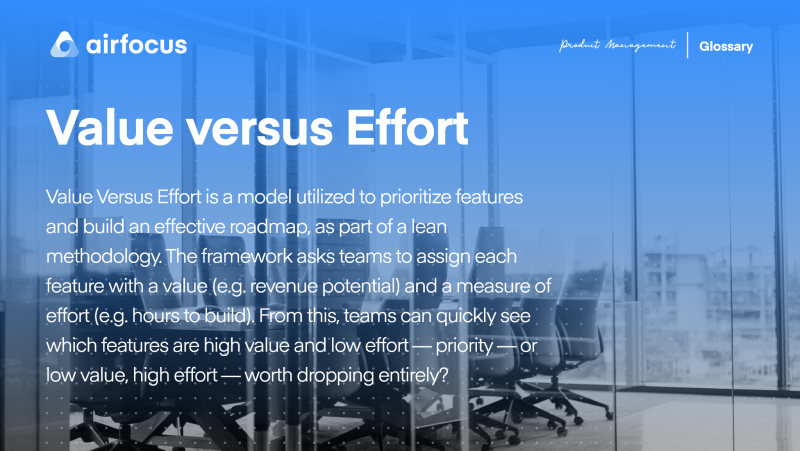Value versus Effort
What is value versus effort?
Definition value versus effort
Value versus effort is a model utilized to prioritize features and build an effective roadmap, as part of a lean methodology. The framework asks teams to assign each feature with a value (e.g. revenue potential) and a measure of effort (e.g. hours to build). From this, teams can quickly see which features are high value and low effort — priority — or low value, high effort — worth dropping entirely?
This shouldn’t be confused with the value versus complexity model. Though the two terms are similar, their definitions differ significantly.
https://www.youtube.com/watch?v=wjQRFnT3Xdg&t The value versus complexity framework allows teams to weigh initiatives against the complexity involved in implementing them. Typically, those initiatives which are considered to be the simplest to implement, yet stand to bring the highest value, will be prioritized. Those falling into the opposite category are left until later or removed from the roadmap altogether.
But with the value versus effort model, product teams consider the effort rather than the complexity involved in completing certain tasks. In this respect, "effort" refers to the number of resources, hours, and investment required to implement features. Obviously, the more effort required to add a feature to a product, the more value it must offer to justify the investment.
How can product teams measure value versus effort?
Product teams can take advantage of a lean prioritization matrix to determine which features are crucial and which pose the highest risk. The aim is to create a product that offers maximum value but with a manageable level of effort. Too much of the latter and not enough of the former can impact potential profitability.
Download Now: Get our eBook on Mastering Prioritization
The lean prioritization matrix involves measuring the value and effort involved in ideas that may be pursued. This can be represented as a simple chart, with a vertical axis marked "value" and the horizontal marked "effort". Product teams work together to assess the amount of each as accurately as possible.
Each feature’s value may be based on such elements as its ability to help attract new users, whether the new feature will benefit all users or just some, the amount of revenue that may be generated by implementing the feature, and how effective it will be in retaining users. This can be a time-consuming process and research will be required to provide the most authentic measurements.
When measuring effort, consider the amount of time (hours per week multiplied by the number of weeks overall, for example), money, and resources required to add a feature to the product successfully.
The position at which you place a feature based on its value and effort will fall into one of four areas. Generally, the standard title for each is "easy wins", "big bets", "incremental", and "money pit".
By dividing the chart into four equal zones, prioritization becomes much simpler. Product teams can gain at-a-glance insights into which features are worth running with and which should be scrapped.
Deciding to eliminate "money pit" ideas can be difficult, especially if they’re a favorite of the team or are considered to have potential. But if this process reveals they actually offer little value in exchange for so much effort, it’s in everyone’s best interest to remove them from the roadmap.
Those features falling into the "easy wins" category involve little effort but promise high value. As a result, you can consider them a given. They deserve to be prioritized and could deliver a better user experience with little investment.
"Big bets" are more of a risk: they stand to bring in high value but at a significant cost. They’re still a priority, but they’re more difficult to implement, particularly for small teams tackling large projects.
"Incrementals" may bring in some value and at a low cost, but are considered non-essential to maximizing a product’s value.
Pros and cons of using the value versus effort model
The main benefit of using the value versus effort model is that product teams can identify which features stand to make the most positive impact on users and at what cost. This creates a rigid structure and reduces the risk of investing time, money, and effort into implementing features that essentially go nowhere.
Download now: Get our 5-minute guide on How To Use the Value vs Effort Model
As a result, the value versus effort model can help to increase productivity and revenue. Product managers may find assigning the right people to the right tasks that bit easier when they know which features are critical to a product’s success.
However, one key drawback of the value versus effort model is the potential for over- or underestimating a feature’s value. Teams may view one idea as being a huge benefit to users, though this proves to be inaccurate down the line. By which point, so much effort would be invested without bringing the return expected.
This is why thorough research is so important. Product teams should understand their target audience, their goals and desired outcomes, their competitors, their market, and common issues with similar solutions. Gathering this information helps empower product teams to make the most accurate valuations of features before prioritizing them.
Likewise, the amount of effort required to implement a feature may be underestimated. As a result, teams would spend more time and money bringing an idea to fruition. This would have a domino effect on other features, potentially causing delays and disruptions down the line.

General FAQ

Glossary categories
Prioritize with confidence

Experience the new way of doing product management








